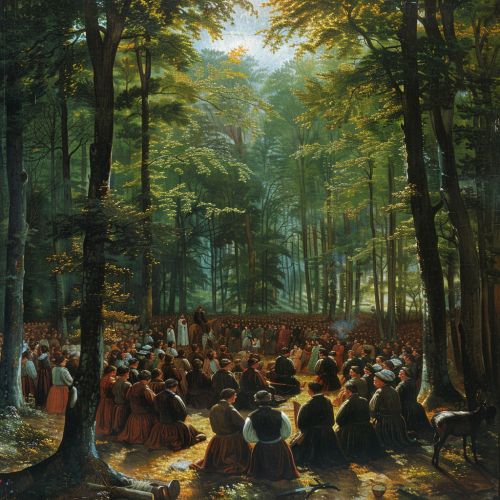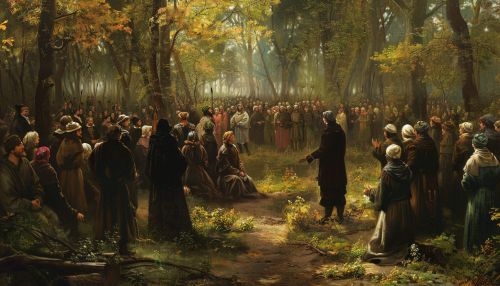Radical Reformation: Difference between revisions
(Created page with "== Introduction == The Radical Reformation was a movement within the broader Protestant Reformation that sought to implement more radical changes in theology, ecclesiology, and social practices. It emerged in the early 16th century as a reaction to both the Roman Catholic Church and the mainstream Protestant reformers like Martin Luther and John Calvin. The Radical Reformation is characterized by its emphasis on the separation of church and state, adult Baptism|baptism...") |
No edit summary |
||
| Line 53: | Line 53: | ||
The Radical Reformation's emphasis on the separation of church and state, religious liberty, and social justice has had a profound impact on modern Christianity. These ideas have influenced various denominations and movements, including the Baptist tradition and the broader evangelical movement. | The Radical Reformation's emphasis on the separation of church and state, religious liberty, and social justice has had a profound impact on modern Christianity. These ideas have influenced various denominations and movements, including the Baptist tradition and the broader evangelical movement. | ||
[[Image:Detail-91889.jpg|thumb|center|Depiction of a 16th-century Anabaptist congregation gathered in a forest for a secret worship service.|class=only_on_mobile]] | |||
[[Image:Detail-91890.jpg|thumb|center|Depiction of a 16th-century Anabaptist congregation gathered in a forest for a secret worship service.|class=only_on_desktop]] | |||
== See Also == | == See Also == | ||
Latest revision as of 04:41, 19 June 2024
Introduction
The Radical Reformation was a movement within the broader Protestant Reformation that sought to implement more radical changes in theology, ecclesiology, and social practices. It emerged in the early 16th century as a reaction to both the Roman Catholic Church and the mainstream Protestant reformers like Martin Luther and John Calvin. The Radical Reformation is characterized by its emphasis on the separation of church and state, adult baptism, and the pursuit of a more egalitarian and communal form of Christianity.
Historical Context
The Radical Reformation began in the early 1520s, primarily in the German-speaking regions of Europe. It was a time of significant religious, social, and political upheaval. The mainstream Protestant Reformation, led by figures such as Martin Luther, had already begun to challenge the authority of the Roman Catholic Church. However, some reformers felt that Luther and others did not go far enough in their reforms. These more radical reformers sought to return to what they perceived as the original practices and beliefs of early Christianity.
Key Figures
The Radical Reformation was spearheaded by several key figures, each with their own unique contributions and theological perspectives.
Thomas Müntzer
Thomas Müntzer was a German preacher and theologian who became one of the most prominent leaders of the Radical Reformation. He advocated for the overthrow of the existing social and political order, which he believed was corrupt and oppressive. Müntzer's radical views led to his involvement in the German Peasants' War, where he sought to establish a theocratic society based on his interpretation of Christian principles.
Conrad Grebel
Conrad Grebel was a Swiss reformer who is often credited with founding the Anabaptist movement. Grebel and his followers rejected infant baptism, arguing that baptism should be a conscious decision made by adults. This belief led to the practice of "rebaptism," which was considered heretical by both Catholic and Protestant authorities.
Menno Simons
Menno Simons was a former Catholic priest who became a prominent Anabaptist leader. He emphasized pacifism, communal living, and the separation of church and state. The Mennonite denomination, which traces its origins to Simons' teachings, remains one of the most enduring legacies of the Radical Reformation.
Theological Beliefs
The Radical Reformation was marked by several distinctive theological beliefs that set it apart from both Catholicism and mainstream Protestantism.
Adult Baptism
One of the most defining features of the Radical Reformation was the rejection of infant baptism in favor of adult baptism. Radical reformers believed that baptism should be a voluntary act of faith, made by individuals who were old enough to understand its significance. This practice led to the term "Anabaptist," meaning "rebaptizer," as many converts were baptized again as adults.
Separation of Church and State
Radical reformers advocated for a clear separation between church and state. They believed that the church should be free from political influence and that Christians should not participate in government or military service. This stance often brought them into conflict with both secular authorities and other Protestant reformers who supported state churches.
Pacifism
Many radical reformers, particularly the Anabaptists, were committed to pacifism. They believed that Christians should not engage in violence or warfare, even in self-defense. This belief was rooted in their interpretation of Jesus' teachings on nonviolence and love for one's enemies.
Social and Political Impact
The Radical Reformation had a significant impact on the social and political landscape of 16th-century Europe. Its emphasis on egalitarianism and communal living challenged the existing social hierarchy and inspired various social movements.
German Peasants' War
The German Peasants' War (1524-1525) was one of the most notable events influenced by the Radical Reformation. Radical reformers like Thomas Müntzer played a key role in the uprising, which sought to address economic and social grievances. Although the revolt was ultimately crushed, it highlighted the growing discontent among the lower classes and the influence of radical religious ideas.
Anabaptist Kingdom of Münster
In 1534, a group of radical Anabaptists led by Jan Matthys and John of Leiden established a theocratic kingdom in the city of Münster. They sought to create a New Jerusalem based on their interpretation of biblical principles. The experiment ended in 1535 when the city was besieged and captured by Catholic and Lutheran forces. The fall of Münster marked a turning point in the Radical Reformation, leading to increased persecution of Anabaptists and other radical groups.
Persecution and Martyrdom
The radical reformers faced intense persecution from both Catholic and Protestant authorities. Their beliefs and practices were considered heretical, and many were executed for their faith.
Martyrs' Mirror
The "Martyrs' Mirror," written by Thieleman J. van Braght in 1660, is a comprehensive account of the persecution and martyrdom of Anabaptists and other radical reformers. The book documents the suffering and steadfastness of those who were willing to die for their beliefs. It remains an important historical and devotional text for Anabaptist communities.
Legacy
The Radical Reformation left a lasting legacy on the Christian tradition and continues to influence various religious movements today.
Mennonites and Amish
The Mennonites and Amish are two of the most well-known groups that trace their origins to the Radical Reformation. Both communities continue to practice adult baptism, pacifism, and communal living, maintaining many of the principles established by early radical reformers.
Influence on Modern Christianity
The Radical Reformation's emphasis on the separation of church and state, religious liberty, and social justice has had a profound impact on modern Christianity. These ideas have influenced various denominations and movements, including the Baptist tradition and the broader evangelical movement.


